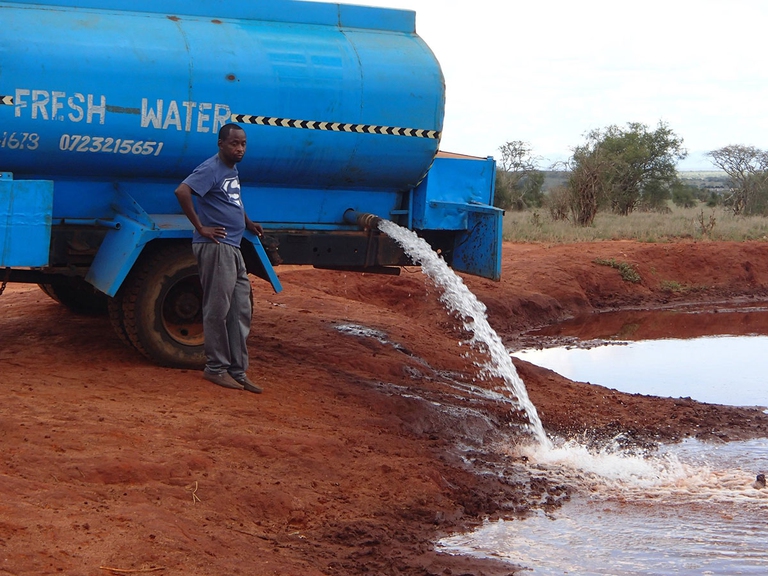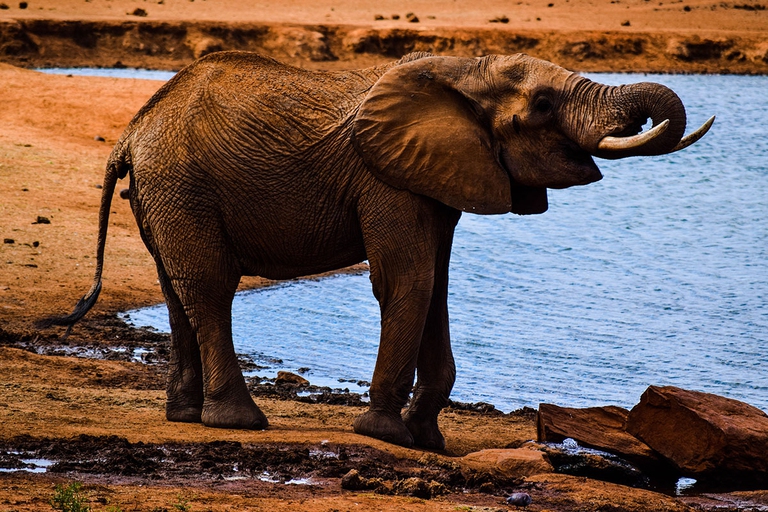
Canada’s wildfire season this year is impacting air quality way beyond the borders of the North American state, reaching as far as Europe.
The story of Patrick Kilonzo Mwalua, the farmer bringing water to animals during droughts, has fascinated many. We asked him about his new project.
As soon as he answers the call, we hear birdsong in the background. “You know, we rarely hear that here, in the city. Looking out the window we mostly see cars and skyscrapers,” we confess, perhaps slightly envious that Patrick Kilonzo Mwalua is spending lockdown immersed in nature. “I love this place,” he tells us. In the pictures he sends us on WhatsApp, fluffy clouds dot the blue sky and the meadow is filled with white flowers. It feels like we can almost smell their delicate scent. There isn’t a building in sight. A little girl, barefoot in the sand, plays with some goats.
To many, Mwalua is a hero. When we point this out to him, he bursts out in sincere and melodious laughter. It seems like fame hasn’t changed him at all: he’s driven by his love for animals and for his land, a remote region of Kenya located about fifty kilometres from Tsavo National Park. It all started in November 2016, when Mwalua decided to rent a truck, get behind the wheel and drive for hours, multiple times a week, to bring water to the animals in the park, whose survival was being threatened by a terrible drought. Ever since, he has made a name for himself as the “water man“. Buffalos and zebras know they can count on him. And now that his first project has taken off thanks to the contribution of those who believed in its potential, Mwalua wants to launch a new one. Something as simple as it is brilliant, that could contribute to safeguarding elephants, bees and communities: cultivating sunflowers.
Why, back in 2016, did you decide to drive for more than fifty kilometres at least four times a week to bring fresh water to wild animals?
At that time there was a drought, it was very hot and dry, with no rainfall at all. The animals were on the brink of dying. Some years before I was in the park and saw many animals die for the same reason, so I decided I had to take action and save them. We humans have contributed to climate change, so I decided I needed to take responsibility for them.
One day, when I was in the park, I saw a buffalo sniffing at an empty water hole. This really touched my heart. I thought that if it had been me, I could have looked for water somewhere else, but animals can’t do this. At that time there was no water anywhere in the park, absolutely nowhere. So I decided to take water to the park, out of the passion that I have for animals, and also because I was so touched.
How has the project developed since?
When I started, I didn’t have any money. The little money I had I used to hire the truck to transport water. Then, when people saw my work on Facebook, they started contributing. There was a lady in the US who started doing some fundraising. From there, I got enough money to buy my truck, and now taking the water to the animals has become a regular, day-to-day thing. I also started building dams, creating watering holes where rainwater would pool. Additionally, I installed solar powered pumps, so now we can pump water to animals many kilometres away.
Do you see the effects of climate change on a daily basis?
Absolutely, yes. I live in a very remote area, it’s a village of about 2,500 people scattered widely. When I was younger, the situation was good. As I grew older, things started changing: for instance, rain patterns used to be more regular, occurring seasonally. But their regularity has been affected by changes in the climate. Now, there are some years when it doesn’t rain at all, and sometimes the rains come when it’s not the right time or the right season. I’ve seen a lot of changes. Even in my village there used to be a lot of trees but because of developments and people trying to establish new farms, and also because people depend on burning charcoal to make a living, a lot of trees have been cut down. Many of the biggest trees as well. When a tree is felled, it takes years for it to grow again. And when there’s a drought, it becomes almost impossible for new trees to grow.
Can you tell us about your new project?
You see, we live close to the park, and there are many ranches in the surrounding area that have lots of wildlife, like elephants and buffalos. So when people plant their crops – especially maize – we have a lot of animals coming to our villages, and they destroy the farms. Elephants like maize. This means there’s a lot of conflict between people and wildlife. So I did some research and found that elephants don’t eat sunflowers. I started planting them, and elephants would come to my farm but never ate any of the plants.
I like sunflowers because when you harvest them you can press the seeds to make oil, which can be sold or used for cooking. The residue from the pressing can even be given to chickens and livestock as feed. At the same time, sunflowers can help attract bees. I’m trying to create beehives in our community, so that bees can help our vegetation. So the sunflowers help preserve the bees, and the bees help preserve the elephants by making them stay away from the farms as elephants are afraid of the insects’ buzzing. So we’re saving elephants and bees, and helping people as well.
Have you launched another fundraising campaign?
Yes, I launched another fundraising campaign. I was also given two machines from India for extracting water from the atmosphere. The fundraising campaign can also be found on the website linked to my organisation: the Mwalua Wildlife Trust.
How has coronavirus impacted your community?
The virus has an effect on us and the animals as well. The rangers who work here depend on tourists for their income. Since no one is coming to the park, they’ve been forced to leave and return home. Without the rangers, the animals are less protected from poachers. It’s a tough situation. Some of the money I raised will go to the rangers, to support them and provide masks and disinfectants so they can work safely.
Siamo anche su WhatsApp. Segui il canale ufficiale LifeGate per restare aggiornata, aggiornato sulle ultime notizie e sulle nostre attività.
![]()
Quest'opera è distribuita con Licenza Creative Commons Attribuzione - Non commerciale - Non opere derivate 4.0 Internazionale.
Canada’s wildfire season this year is impacting air quality way beyond the borders of the North American state, reaching as far as Europe.
Two new studies have revealed that the retreat of the Thwaites Glacier is happening in a different, more complex way than previously understood.
A study of tissue samples from killer whales in Canada was the first to find a dangerous toxic chemical, known as 4NP, in the animals’ flesh.
The South African government is clamping down on the controversial multimillion-dollar lion-breeding industry, thanks to pressure from activists.
Switzerland’s glaciers are shrinking, with a new study finding that they have lost more than half their total volume since the early 1930s.
Santa Olalla, the last permanent lagoon in the park, has disappeared under the pressure of drought, overexploitation, and illegal wells.
Vulture populations in southern Asia experienced a 99% collapse and for a long time nobody knew why. Then, a historic discovery saved them.
The Indian government has pledged to reintroduce cheetahs, classified as a “vulnerable” species by the IUCN, into the wild. The animals will be transferred from Africa.
In Australia, more and more platypuses are getting caught in plastic waste. Efforts to protect this species need to be increased.












